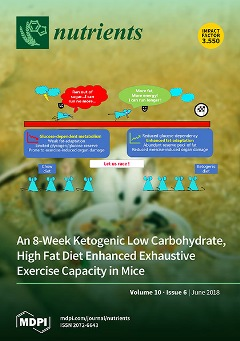During the postmenopausal period, the risk of cardiovascular diseases is increased in many obese women and is associated with a worse cardiometabolic profile and a sub-chronic low-grade systemic inflammation caused by a gut barrier permeability dysfunction. Here, we tested whether administration of two different dosages of the multispecies probiotic Ecologic
® Barrier influenced the cardiometabolic biochemical parameters and lipopolysaccharide levels, the latter used as a marker of increased gut permeability in obese postmenopausal women. A total of 81 obese Caucasian postmenopausal women participated in the trial. The subjects were randomly assigned to three groups that received a placebo, a low dose (LD) (2.5 × 10
9 colony forming units (CFU) per day), or a high dose (HD) (1 × 10
10 CFU per day) of lyophilisate powder containing live multispecies probiotic bacteria. The probiotic supplement was administered each day in two equal portions for 12 weeks. We found significant (
p < 0.05) favorable changes (mostly large or medium effects) in the evaluated parameters in both the HD and LD groups but not in the placebo group. In the HD group, lipopolysaccharide, waist, fat mass, subcutaneous fat, uric acid, total cholesterol, triglycerides, low-density lipoprotein cholesterol, glucose, insulin, and insulin-resistant index (HOMA-IR) were improved. Similar changes were observed in the LD group, except for lipopolysaccharide, uric acid, triglycerides, and glucose levels. Additionally, significant differences were observed in both groups in terms of fat percentage and visceral fat. When the mean changes were compared between the three groups, statistically significant differences in lipopolysaccharide levels, uric acid, glucose, insulin, and HOMA-IR were found. Post hoc tests revealed significant differences in the mean changes (mostly medium effects) between the HD and LD groups for uric acid, glucose, insulin, and HOMA-IR. In the 12-week randomized, placebo-controlled, double-blind intervention, we observed that supplementation with the multispecies probiotic Ecologic
® Barrier favorably affected the risk factors in a dose-dependent manner, showing beneficial effects on the cardiometabolic parameters and gut permeability of the patients. Our results suggest that this product can be effective in the prevention and treatment of cardiovascular diseases in obese postmenopausal women.
Full article






